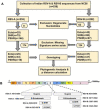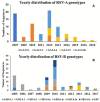Reclassification of respiratory syncytial virus genotypes in India
- PMID: 37009257
- PMCID: PMC10050612
- DOI: 10.1007/s13337-022-00802-x
Reclassification of respiratory syncytial virus genotypes in India
Abstract
Respiratory syncytial virus (RSV) is known to be the major cause of lower respiratory tract infections in infants and in the elderly. RSV was recently reclassified and simplified into three genotypes of the RSV-A subgroup (GA1-GA3) and into seven genotypes of the RSV-B subgroup (GB1-GB7). This classification strategy was not implemented globally. This study intended to reclassify the sequences that were submitted in GenBank till September 2021 from India. The gene sequences of the ectodomain region, second hypervariable region (SHR), and the partial second hypervariable region (PSHR) of the G gene were selected for the analysis. 25 ectodomain, 36 s hypervariable, and 19 partial second hypervariable regions of the RSV-A subgroup and 42-ectodomain, 49-s hypervariable region and 11-partial second hypervariable region of RSV-B subgroup were used for phylogenetic analysis. P-distance was calculated to support the genotype determination done by phylogenetic analysis. Phylogenetic analysis revealed that GA2.3.1, GA2.3.3, GA2.3.4, GA2.3.5, and GA2.3.6b lineages of GA2 genotype for RSV-A; and GB5.0.1, GB5.0.2, GB5.0.3, GB5.0.4a, GB5.0.4c, GB5.0.5a, GB5.0.5c lineages of GB5 genotype and GB7 genotype for RSV-B were that circulated in India. This work has implication for RSV vaccine research, and also for strategies for the prevention and control of RSV infection in humans.
Supplementary information: The online version contains supplementary material available at 10.1007/s13337-022-00802-x.
Keywords: Ectodomain region; Genotype; India; Respiratory syncytial virus; Second hypervariable region.
© The Author(s), under exclusive licence to Indian Virological Society 2022, Springer Nature or its licensor (e.g. a society or other partner) holds exclusive rights to this article under a publishing agreement with the author(s) or other rightsholder(s); author self-archiving of the accepted manuscript version of this article is solely governed by the terms of such publishing agreement and applicable law.
Figures








Similar articles
-
Molecular epidemiology of respiratory syncytial virus among children and adults in India 2016 to 2018.Virus Genes. 2021 Dec;57(6):489-501. doi: 10.1007/s11262-021-01859-4. Epub 2021 Sep 15. Virus Genes. 2021. PMID: 34524602 Free PMC article.
-
Toward unified molecular surveillance of RSV: A proposal for genotype definition.Influenza Other Respir Viruses. 2020 May;14(3):274-285. doi: 10.1111/irv.12715. Epub 2020 Feb 5. Influenza Other Respir Viruses. 2020. PMID: 32022426 Free PMC article.
-
A multi-center study on Molecular Epidemiology of Human Respiratory Syncytial Virus from Children with Acute Lower Respiratory Tract Infections in the Mainland of China between 2015 and 2019.Virol Sin. 2021 Dec;36(6):1475-1483. doi: 10.1007/s12250-021-00430-7. Epub 2021 Aug 16. Virol Sin. 2021. PMID: 34398429 Free PMC article.
-
Respiratory syncytial virus infections in India: Epidemiology and need for vaccine.Indian J Med Microbiol. 2018 Oct-Dec;36(4):458-464. doi: 10.4103/ijmm.IJMM_19_5. Indian J Med Microbiol. 2018. PMID: 30880691 Review.
-
Global distribution of respiratory syncytial virus A and B infections: a systematic review.Pathog Glob Health. 2022 Oct;116(7):398-409. doi: 10.1080/20477724.2022.2038053. Epub 2022 Feb 14. Pathog Glob Health. 2022. PMID: 35156555 Free PMC article.
Cited by
-
Genetic Diversity of Human Respiratory Syncytial Virus during COVID-19 Pandemic in Yaoundé, Cameroon, 2020-2021.Microorganisms. 2024 May 8;12(5):952. doi: 10.3390/microorganisms12050952. Microorganisms. 2024. PMID: 38792782 Free PMC article.
References
-
- Abdul SS, Dar L, Kumar L, Brijwal M, Choudhary A, Ray A, et al. 1767 Incidence of respiratory syncytial virus infection among adults undergoing hematopoietic stem cell transplantation: a prospective study from India. Open Forum Infect Dis. 2019 Oct 23;6(Supplement_2):S651.
-
- Agarwal SC, Bardoloi JN, Mehta S. Respiratory syncytial virus infection in infancy and childhood in a community in Chandigarh. Indian J Med Res. 1971;59(1):19–25. - PubMed
-
- Agrawal AS, Sarkar M, Ghosh S, Chawla-Sarkar M, Chakraborty N, Basak M, et al. Prevalence of respiratory syncytial virus group B genotype BA-IV strains among children with acute respiratory tract infection in Kolkata. Eastern India J Clin Virol. 2009;45(4):358–361. doi: 10.1016/j.jcv.2009.05.013. - DOI - PubMed
LinkOut - more resources
Full Text Sources

